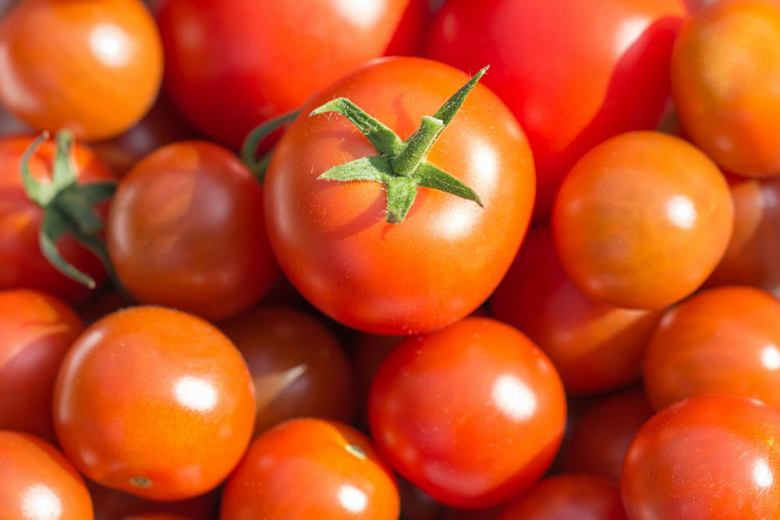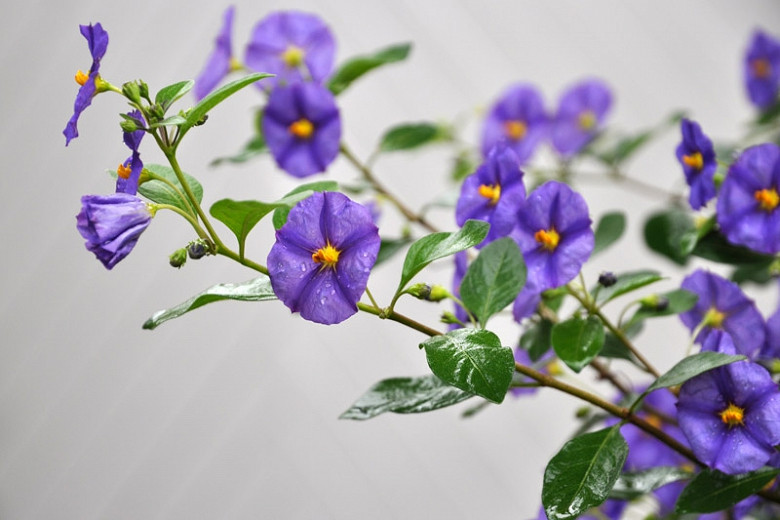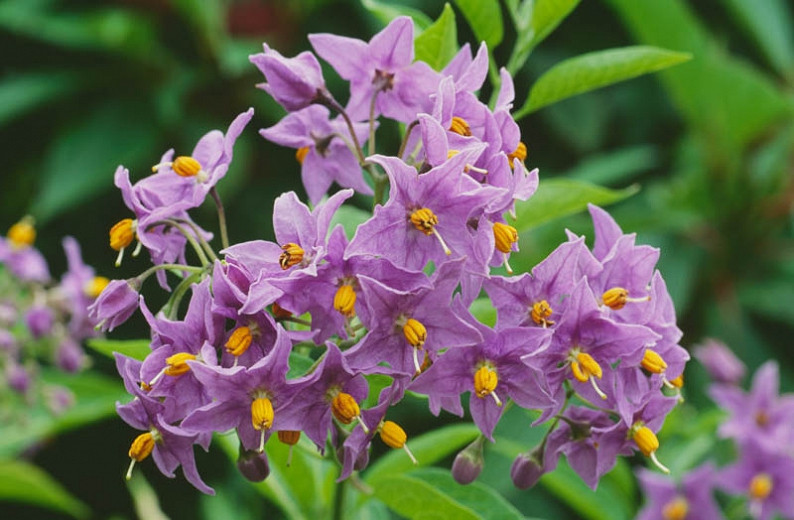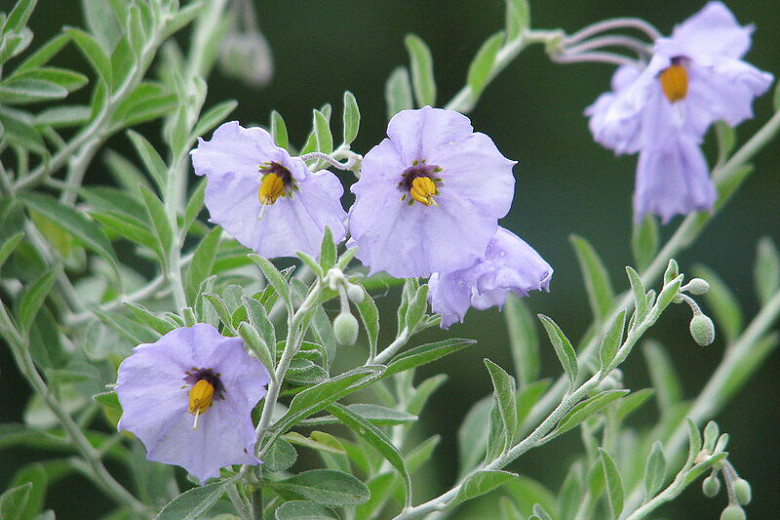Solanum lycopersicum (Tomato)
A garden favorite, tomatoes (Solanum lycopersicum) are tender perennials that are grown as annuals in temperate climates. Easy to grow and prolific, tomatoes are the most widely grown garden plants. There are thousands of varieties and cultivars of tomatoes – and choices for every taste and every region.
A garden favorite, tomatoes (Solanum lycopersicum) are tender perennials that are grown as annuals in temperate climates. Easy to grow and prolific, tomatoes are the most widely grown garden plants. There are thousands of varieties and cultivars of tomatoes – and choices for every taste and every region.
- Botanically, a tomato is a fruit — a berry. However, the tomato is considered a culinary vegetable because it has a much lower sugar content than culinary fruits and is more savory than sweet.
- Depending on the variety or cultivar, tomato fruits come in various sizes, shapes, and colors. Tomatoes can be greenish-white, yellow, orange, pink, purple, or red. They can be small, the size of a grape, or well over a pound apiece.
- The erect or ascending stems are covered with sticky, dense hairs. The velvety, densely hairy, and strongly scented compound leaves are alternate, up to 4-10 in. long (10-25 cm), with 5-9 leaflets with serrated margins.
- The flowers are yellow, star-shaped, five-petaled blooms with recurved petals in clusters of 3 to 12 blooms.
- Native to Peru, tomatoes have spread worldwide after the Spanish colonization. The Spanish distributed the tomato throughout their colonies in the Caribbean and took it to the Philippines, from where it spread to southeast Asia and then the entire Asian continent. The Spanish also brought the tomato to Europe, where it grew easily in Mediterranean climates.
- Today, China is the largest tomato-producing country, followed by the United States, Turkey, India, and Italy.
Main Types of Tomatoes
- Determinate Tomatoes (Bush Tomatoes): they grow to a certain height and stop, putting all their energy into producing fruit heavily over 4-6 weeks. They are generally productive earlier than the vining varieties and not in the latter part of the growing season. Growing 2-3 feet tall (60-90 cm), Determinate Tomatoes do not require staking or caging. These plants are ideal for containers and small spaces. Smaller types can also be grown in hanging baskets, with the stems trailing over the sides. Determinate Tomatoes are the easiest type to grow and need little maintenance besides watering and feeding. Most paste tomatoes are determinate.
- Indeterminate Tomatoes (Cordon Tomatoes or Vining Tomatoes): they grow and produce fruiting clusters until frost. They boast the largest types of mid to late-season tomatoes. Growing up to 6 feet tall or more (180 cm), Indeterminate Tomatoes need staking. They are ideal when space is limited, as they grow vertically, tall and narrow. Indeterminate Tomatoes require regular maintenance such as watering, feeding, tying to supports, and pinching out side shoots. Most beefsteak and cherry tomatoes are indeterminate.
Choosing Tomatoes
- Choose cultivars that are adapted to local growing conditions:
Early Tomatoes (less than 70 days to harvest)
Mid-season Tomatoes (70 to 80 days to harvest)
Late-season Tomatoes (80 days or more to harvest)
Cool-summer Tomatoes – these will ripen fruit where heat is too low for most tomatoes.
- Choose cultivars that are resistant to problems and disease. Resistant cultivars are usually denoted in seed catalogs as follows:
F = Fusarium resistant,
V = Verticillium resistant,
T = Tobacco mosaic virus resistant,
N = Nematode resistant,
TSWV = Tomato spotted wilt virus resistant.
Growing Tomatoes
- Grows up to 3-10 ft. tall (90-300 cm) and 1-4 ft. wide (30-120 cm), depending on the variety.
- Performs best in fertile, neutral to acidic (pH between 6.0 and 6.8), moist but well-drained soil in full sun.
- Work in plenty of compost before planting to add organic matter.
- Keep the soil evenly moist but not soggy, and do not allow it to dry out. Avoid wetting leaves when watering to help prevent diseases.
- Depending on the variety, tomatoes take 60 days to more than 100 days to harvest.
- Tomatoes require moderate levels of nitrogen and phosphorus and moderate to high levels of potassium and calcium. Feed every 10–14 days to boost fruiting with a high-potassium liquid fertilizer once the first fruits start to swell.
- Tomatoes are ideal for growing in raised beds or containers outdoors or in a greenhouse.
- Tomatoes grow best between 75-90°F (24-32°C). Temperatures over 100°F (37°C) can kill blossoms, while temperatures below 50°F (10°C) can cause chilling injury.
- Staking your tomato plants will keep the stems from breaking or drooping from the weight of the tomatoes.
- Mulch to retain moisture, keep soil from splashing the lower leaves, and control weeds.
- Remove all side shoots as they appear on vining tomatoes. Pinch the growing tip when the plant has formed seven trusses under cover or four trusses outdoors.
- Tomatoes are susceptible to many pests. Keep an eye out for stink bugs, cutworms, tomato hornworms, tobacco hornworms, aphids, cabbage looper, whiteflies, tomato fruit worms, flea beetles, red spider mites, slugs, and the Colorado potato beetle.
- Tomatoes are susceptible to many diseases, including blights, blossom end-rot, Verticillium wilt, Fusarium wilt, Tobacco mosaic virus, and bacterial and viral diseases. Tomatoes are rabbit-resistant.
- Tomatoes are propagated by seed.
- The leaves, stems, and green unripe fruits contain small amounts of toxin alkaloids (tomatine and solanine). They are poisonous and toxic to humans, cats, dogs, and horses.
Tomato: Companion Planting
- Excellent companion plants for tomatoes are asparagus, borage, calendula, carrots, celery, coneflowers, dill, oregano, garlic, lettuce, nasturtium, onions, parsley, sweet basil, sunflowers, sweet alyssum, and thyme.
- Do not plant tomatoes where potatoes, eggplants, or peppers have been planted within the past 3 to 5 years.
- Do not plant broccoli, cabbage, cauliflower, kohlrabi, corn, potatoes, or fennel near tomatoes.
Requirements
| Hardiness | 2 – 11 |
|---|---|
| Climate Zones | 1, 1A, 1B, 2, 2A, 2B, 3, 3A, 3B, 4, 5, 6, 7, 8, 9, 10, 11, 12, 13, 14, 15, 16, 17, 18, 19, 20, 21, 22, 23, 24, A1, A2, A3, H1, H2 |
| Plant Type | Fruit |
| Plant Family | Solanum |
| Exposure | Full Sun |
| Season of Interest | Spring (Late)Summer (Early,Mid,Late)Fall |
| Height | 3' – 10' (90cm – 3m) |
| Spread | 1' – 4' (30cm – 120cm) |
| Water Needs | Average |
| Maintenance | Average, High |
| Soil Type | Clay, Loam, Sand |
| Soil pH | Acid, Neutral |
| Soil Drainage | Moist but Well-Drained |
| Tolerance | Rabbit |







